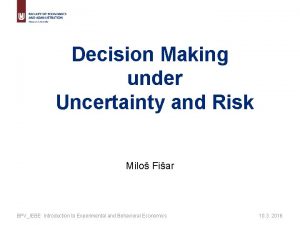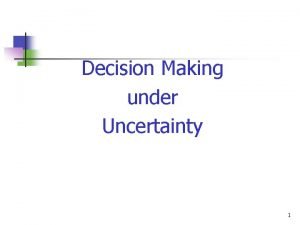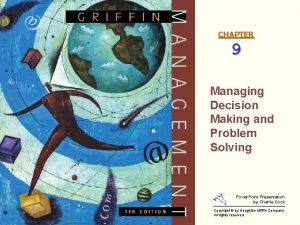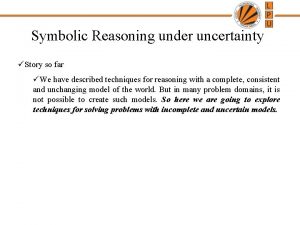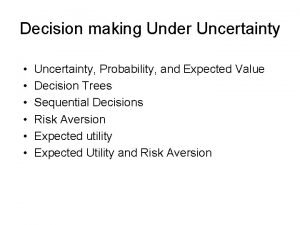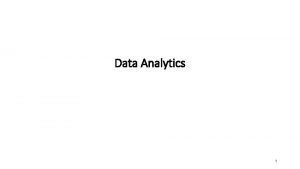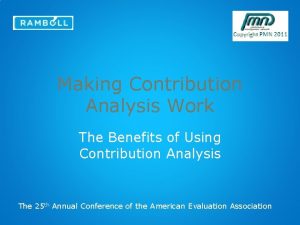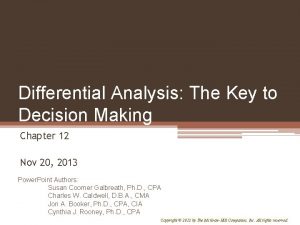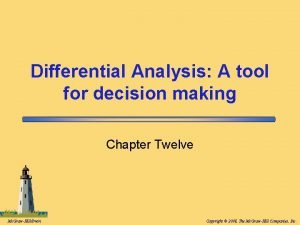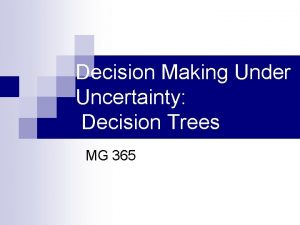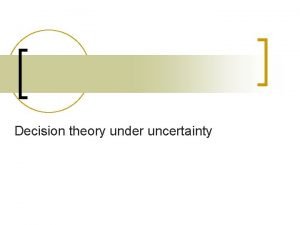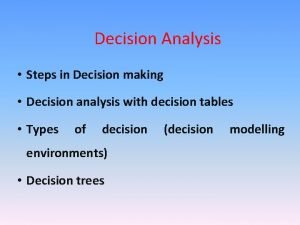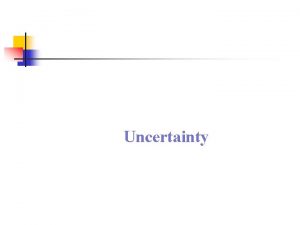Decision Analysis Decision Making Under Uncertainty Techniques play















- Slides: 15

Decision Analysis • Decision Making Under Uncertainty – Techniques play an important role in business, government, everyday life, college football rankings – How can a manager provide a rational methodology for decision making and analysis in the face of uncertainty? – How does a manager chose among alternatives in an optimal fashion when those alternatives may be numerous and conflicting? DSCI 3223 1

Components of Decision Making • State – An actual event that may occur in the future • Decision – Options from which a decision maker can chose • Outcomes – The result of a combination of states and decisions DSCI 3223 2

Payoff Table • A means to organize states, decisions, and outcomes e. g. , States Decisions a b 1 payoff 1 a payoff 1 b 2 payoff 2 a payoff 2 b DSCI 3223 3

Payoff Table Example • An investor must decide among an apartment building, an office building, and a warehouse. States Decisions Good Bad Apartment $50, 000 $30, 000 Office 100, 000 -40, 000 Warehouse 30, 000 10, 000 DSCI 3223 4

Decision Criteria • • • Maximax Maximin Minimax Regret Hurwicz Equal Likelihood DSCI 3223 5

Maximax • Decision maker selects the decision that will result in the maximum of the maximum payoffs Decisions Apartment Office Warehouse Good $50, 000 100, 000 30, 000 • Decision would be to purchase the office • Decision completely ignores down side, loss of $40, 000 • Assumes a very optimistic future DSCI 3223 6

Maximin • Decision maker selects the decision that will result in the maximum of the minimum payoffs Decisions Apartment Office Warehouse Bad $30, 000 -40, 000 10, 000 • Decision would be to purchase the apartment • Decision is relatively conservative • Assumes a very pessimistic future DSCI 3223 7

Minimax Regret • Decision maker attempts to avoid regret by selecting the decision alternative that minimizes the maximum regret • Select the maximum payoff under each state: – Good ----> $100, 000 – Bad ------> 30, 000 • Regret is then calculated as follows: – Good ----> $100, 000 - payoff for each decision – Bad ------> 30, 000 - payoff for each decision DSCI 3223 8

Minimax Regret • The calculations for the example States Decisions Apartment Office Warehouse Good $100, 000 - 50, 000 = 50, 000 $100, 000 - 100, 000 = 0 $100, 000 - 30, 000 = 70, 000 Bad $30, 000 - 30, 000 = 0 $30, 000 - (-40, 000) = 70, 000 $30, 000 - 10, 000 = 20, 000 • Chose the decision which minimizes this regret • Purchase the apartment building • Decision maker experiences the least amount of regret DSCI 3223 9

Hurwicz Criterion • A compromise between the maximax and maximin criterions • Payoffs are weighted using a coefficient of optimism, • A measure of the decision maker’s optimism regarding the outcome of the events • 0< <1 DSCI 3223 10

Hurwicz Criterion • The is multiplied by the best payoff and (1 - ) is multiplied by the worst payoff and these values are added together • This criterion is a simple weighting scheme • However, must be determined by the decision maker and is completely subjective • The Hurwicz Criterion is completely subjective DSCI 3223 11

Hurwicz Criterion • Given = 0. 4, then 1 - = 0. 6, Decisions Apartment Office Warehouse Values $50, 000*(0. 4) + $30, 000*(0. 6) $100, 000 *(0. 4) - $40, 000*(0. 6) $30, 000 *(0. 4) + $10, 000*(0. 6) = $38, 000 = $16, 000 = $18, 000 • Hurwicz criterion specifies selection corresponding to the maximum weighted average • Apartment building DSCI 3223 12

Equal Likelihood or La. Place • Hurwicz Criterion when = 0. 5 Decisions Apartment Office Warehouse Values $50, 000*(0. 5) + $30, 000*(0. 5) $100, 000 *(0. 5) - $40, 000*(0. 5) $30, 000 *(0. 5) + $10, 000*(0. 5) = $40, 000 = $30, 000 = $20, 000 • Equal likelihood criterion specifies selection corresponding to the maximum weighted average • Apartment building DSCI 3223 13

Limitations of Weighting Methods • Regardless of how a is determined it is a subjective measure, even with equal likelihood • The degree of the decision maker’s optimism is reflected in • Untrained decision maker’s generally choose incorrectly • How would you choose ? DSCI 3223 14

Summary of Techniques Criterion Maximax Maximin Minimax regret Hurwicz Equal Likelihood DSCI 3223 Decision Office Building Apartment 15
 Decision-making under uncertainty
Decision-making under uncertainty Decision-making under uncertainty
Decision-making under uncertainty Non programmed decision example
Non programmed decision example Group decision making techniques
Group decision making techniques Minimalist reasoning in ai
Minimalist reasoning in ai Capital budgeting under risk and uncertainty
Capital budgeting under risk and uncertainty Expected profit under uncertainty
Expected profit under uncertainty Objectives of decision making
Objectives of decision making Dividend decision in financial management
Dividend decision in financial management Ratio data example
Ratio data example Swot analysis decision making
Swot analysis decision making Sebastian lemire
Sebastian lemire Differential analysis the key to decision making
Differential analysis the key to decision making Differential analysis the key to decision making
Differential analysis the key to decision making I've got a friend we like to play we play together
I've got a friend we like to play we play together Louise made the chocolate cake active or passive
Louise made the chocolate cake active or passive
